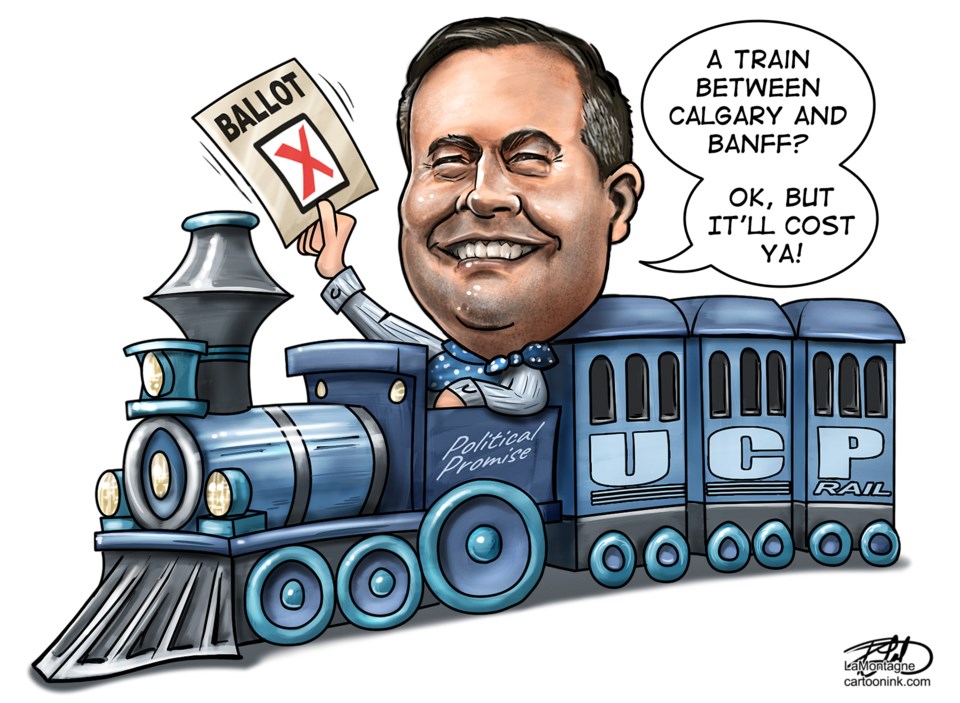The much discussed rail link between Calgary International Airport and Banff received another vocal and more importantly, financial supporter.
Invest Alberta – the provincial government’s investment attraction Crown corporation – joined the Alberta government and the Canada Infrastructure Bank’s memorandum of understanding as the push for a rail line into the Bow Valley continues to slowly move forward.
The proposed public-private project would see a 150-kilometre rail service go from the Calgary International Airport to Banff with two extra stops in Calgary and also Cochrane, Morley and Canmore.
The organizations released information a development plan will likely be forthcoming before the year is out to figure out the long-term costs and if all goes well, construction potentially starting sometime in 2022.
The train has the potential to address issues faced daily by local Bow Valley residents. The issues of traffic congestion as people come far and wide to visit one of the most scenic areas in North America as well as the increase in CO2 emissions that come with the traffic are mounting.
The project has several public partners committed, while the main private booster is Liricon Capital – a holding company led by Banff residents Jan and Adam Waterous – who run Mount Norquay Ski Resort and leases the roughly 17.4 hectares lands of the Banff train station.
Liricon is also attempting to have an aerial gondola go from the train station to the base of Norquay ski hill, though Parks Canada said no to it in 2019. The proposed gondola has also seen Banff councillor Peter Poole strangely accused of a conflict of interest by an unknown party, whose name or names were withheld on the grounds of it being a threat to their safety, mental or physical health.
A train from Calgary to Banff is nothing new, with one running for decades before declining ridership led to it being cut by ViaRail in 1990 after the federal government scaled back its funding.
While the announcement brought increased interest in the rail line, there are still significant questions. A 2019 study between Calgary, Canmore, Cochrane, Lake Louise and Morley found it would only work with provincial and federal funding.
Who is paying for what and how much is still unknown.
It would also see the rail line go through busy urban areas and more consulting with several municipalities and the Stoney Nakoda First Nation be undertaken.
The Town of Canmore has previously voiced concerns on proceeding until more information is collected. Economic benefits, capital and operating costs to the communities on the route and where the train stations will go and who will be footing the bill are just a few unanswered questions.
In Canmore, a second rail line would also add more delays by up to 10 train trips heading into Banff and another 10 returning to Calgary leading to several more halts to traffic along the CP line.
There’s also the issue of timing.
Laying 150 kilometres of rail line, building several train stations with parking and figuring out the logistics won’t happen overnight – it could take several years and likely hundreds of millions of dollars.
There’s also worry on the impact to wildlife, especially with near weekly reports of bears, wolves or other animals being hit after wandering too close to the existing CP rail lines.
The possibility of buses being used instead has continued to linger, particularly since the logistics in running them could have a program launched significantly more quickly than rail lines.
The Calgary-Bow Valley Mass Transit Feasibility study from 2018 showed a comparison between the rail and bus options for the corridor. The 312-page report completed a detailed analysis of rail and bus use, potential stops, possible revenues and operating costs.
A 16-page document by Liricon that covers the highlights of the Banff train station lands, ARP stresses “clearly the status quo (in Banff) is not working.”
It’s not wrong.
The amount of visitation to Banff National Park and the Bow Valley won’t be declining.
After the Alberta government expressed its hope to see tourism expand by twice as much by 2030, the Bow Valley is only going to see more people visiting their communities.
It means more traffic, more people, more CO2 emissions and more impact on wildlife.
The system in place isn’t working, but what can fix it is still a question mark.




